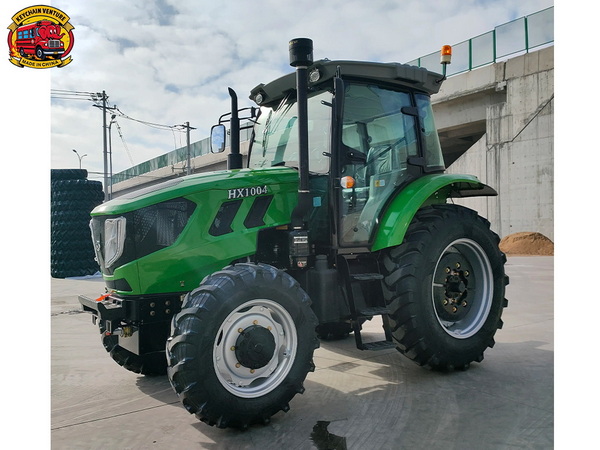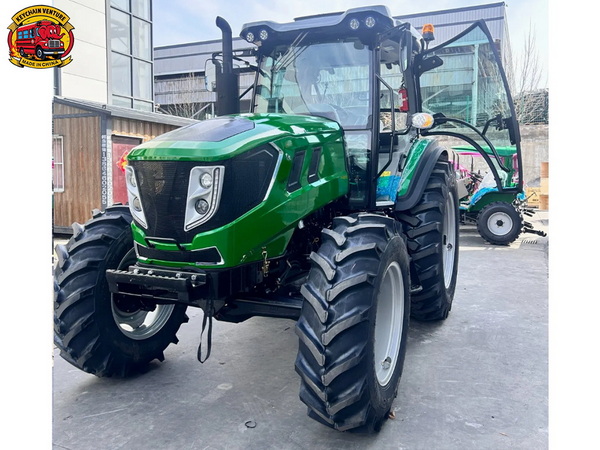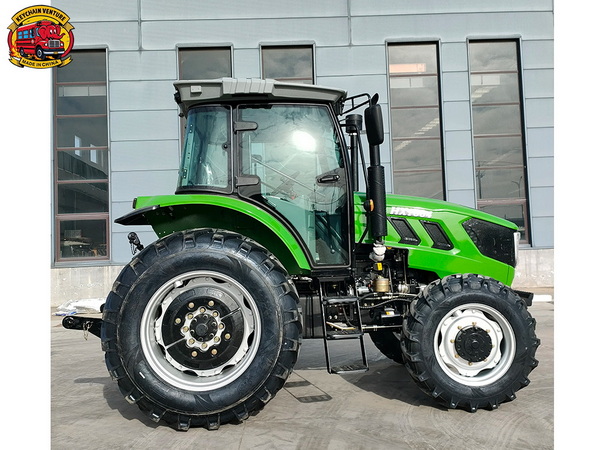Views: 222 Author: Amanda Publish Time: 2025-08-20 Origin: Site








Content Menu
● Introduction to Used Tractors
● Key Factors Influencing a Used Tractor's Value
>> Features and Specifications
● Methods to Accurately Appraise a Used Tractor
>> Test Driving
>> Professional Appraisal Services
● Important Documentation and Inspection Checklist
● Tips for Negotiating Price on a Used Tractor
>> Consider Total Ownership Cost
● Common Mistakes to Avoid When Buying a Used Tractor
● FAQ
>> 1. How do engine hours affect the value of a used tractor?
>> 2. Can I trust online valuation tools for a used tractor?
>> 3. What documents are essential to verify when buying a used tractor?
>> 4. Should I consider the tractor's brand when valuing it?
>> 5. How important is a test drive when buying a used tractor?
In the competitive commercial vehicle market, understanding how to value a used tractor is essential for buyers, sellers, and fleet managers alike. As a leading supplier of commercial vehicles, KeyChain Venture Co., Ltd. provides high-performance bus and heavy truck solutions globally, and we recognize the critical importance of making informed decisions when it comes to used tractors. In this comprehensive guide, we will walk you through the key factors affecting the value of a used tractor, methods to accurately assess its worth, and practical tips to ensure you secure the best deal possible.

Used tractors are the backbone of many commercial transport and logistics operations worldwide. Unlike new tractors, used models provide excellent value for companies looking to expand their fleets without incurring the high cost of brand-new equipment. However, the challenge lies in accurately valuing these machines amidst varying conditions, usage histories, and market trends.
Why Value Matters
Accurately assessing a used tractor's value ensures that you neither overpay nor overlook a potentially costly investment. Knowing the value helps fleet operators maintain budget discipline while securing reliable performance for their logistics needs.
In addition, understanding how to evaluate a used tractor supports better asset management by allowing companies to plan replacement cycles wisely, optimize depreciation for accounting and tax purposes, and benchmark their fleet's effectiveness compared to industry standards.
Several critical variables influence the valuation of a used tractor:
The tractor's model year and total engine hours provide a snapshot of its usage and potential remaining lifespan. Generally, lower hours indicate less wear and longer expected life.
It's important to understand that engine hours are often a better gauge than just the tractor's age because some tractors may be older but lightly used, maintaining a higher residual value than newer but heavily used units.
The overall mechanical condition is paramount when valuing a used tractor. This includes aspects such as:
- Engine performance and noise levels
- Transmission smoothness and gear shifts
- Brake effectiveness
- Suspension condition and shock absorbers
- Electrical systems including lighting and dashboard indicators
A tractor with mechanical issues will require costly repairs, which reduces its resale price.
A detailed, up-to-date maintenance record adds significant value by demonstrating the tractor has been serviced routinely, replaced parts proactively, and had no neglected repairs. Conversely, tractors without documented maintenance may warrant lower valuations due to uncertainty about their condition.
Certain brands and models retain their value better because of parts availability, dealer support, fuel efficiency, and reputation for durability. For many logistics companies, investing in a widely recognized brand can lower long-term operating costs and downtime risk.
Tractor values vary widely depending on geographic market demand. For example, in regions with booming construction or agricultural activity, some models may command a premium. Conversely, oversupply in certain areas can drive prices down.
International aspects are also critical; export-import fees, emission regulations, and availability of compatible fuel types affect the usability and value of used tractors in different countries.
Additional features such as enhanced fuel efficiency technologies, safety systems (like ABS, lane assist), driver comfort (air conditioning, advanced seats), and telematics integration increase the tractor's market appeal and therefore its value.
Custom modifications, if professional and compliant with safety regulations, may also contribute positively, though poorly executed alterations can detract.

A thorough hands-on physical inspection is essential. This includes:
- Tires and Wheels: Check for uneven wear or damage which can indicate alignment issues.
- Frame and Chassis: Look for signs of rust, cracks, or welding repairs that compromise structural integrity.
- Cab and Interior: Evaluate condition of seats, dashboard instruments, controls, and climate control systems.
- Attachments: If the tractor includes fifth wheels, hitches, or auxiliary equipment, confirm proper functioning and compatibility.
Visual signs of neglect or damage often foreshadow deeper mechanical problems.
A test drive allows first-hand evaluation of:
- Engine responsiveness under load
- Transmission changing smoothness
- Braking distance and feel
- Steering precision and suspension comfort
- Noise levels and vibrations
Test drives near the seller's premises may not reveal full issues, so try to drive under varied conditions if possible.
Several industry platforms aggregate market data, auction outcomes, and dealer listings to provide estimated market values based on tractor specifications, age, and mileage. These tools help set a price baseline but cannot substitute for physical inspection.
Certified appraisers and trusted dealers have access to in-depth market trend data and possess diagnostic skills to identify hidden issues. Utilizing their services provides a reliable valuation, particularly for high-value or fleet purchases.
When assessing a used tractor, make sure to verify the following documents and conditions:
- Title and Registration: Confirm that the tractor's ownership is clear, and it isn't subject to liens or unresolved legal claims.
- Proof of Ownership: Originals or certified copies should be presented.
- Maintenance and Repair Records: Complete servicing logs illustrate care and support valuation confidence.
- Warranty Status: Some tractors may still be under transferable factory or extended warranty, which enhances value.
- Inspection for Recalls or Defects: Verify that manufacturer recalls have been addressed, as outstanding recalls can reduce value significantly.
- Compliance Certificates: Ensure the tractor meets local emissions, environmental, and safety standards.
- Accident or Damage History: Obtain any available collision reports or repair assessments.
Use online tools, industry reports, and market comparisons to establish a reasonable price range for the specific tractor model and condition.
Any discovered mechanical, cosmetic, or documentation issues should be highlighted to negotiate a fair price deduction or seller-supported repairs.
Buying towards the end of a quarter or fiscal year when sellers might be motivated to liquidate inventory can yield better pricing and terms.
Factor in insurance rates, financing fees, expected future repairs, fuel efficiency, and taxes. Sometimes paying a slightly higher upfront cost for a better-maintained tractor reduces total cost of ownership.
Positive relationships with dealers or owners can lead to more transparent deals and may provide value-added benefits like free servicing or support post-sale.
- Skipping Detailed Inspections: Relying solely on appearances or seller claims can result in unexpected failures.
- Not Verifying Maintenance Records: Absence of service logs can hide neglect or serious operational risks.
- Ignoring Total Cost of Ownership: Focusing only on sticker price without budgeting for repairs or higher fuel consumption.
- Forgoing a Test Drive: Missing out on critical assessment of operational smoothness and potential hidden faults.
- Neglecting Legal Documentation: Overlooking title status can expose buyers to ownership disputes or financial liabilities.
- Overlooking Market Conditions: Failing to benchmark prices against current local or global demand may lead to paying too much.
Valuing a used tractor requires a combination of technical knowledge, market research, and careful inspection. Whether you're purchasing from a dealer, auction, or private seller, understanding the key factors that influence value can save you money and ensure a reliable investment for your business. By following the outlined steps—inspecting the tractor's condition, verifying documentation, using valuation tools, and negotiating effectively—you can confidently acquire a used tractor that fits your operational needs and budget.
A well-valued used tractor increases fleet efficiency, reduces downtime, and maximizes return on investment, reinforcing your company's position in the competitive commercial vehicle marketplace. Trust KeyChain Venture Co., Ltd. to provide expert guidance and quality vehicles that meet rigorous international standards.

Engine hours are a direct indicator of the tractor's operational wear. Lower hours usually increase value because there is generally more usable life left, while high hours may indicate upcoming maintenance or potential failures.
Online valuation tools are useful starting points for estimating market prices. However, they should always be supplemented by physical inspections and, if possible, professional appraisals to provide an accurate value.
The title, registration, proof of ownership, maintenance records, warranty info, and compliance certificates are crucial to verify. These documents ensure clear ownership and proper maintenance history.
Absolutely. Well-established brands often yield higher resale values due to better reliability, availability of parts, dealer support, and higher demand in the market.
A test drive is critical as it reveals the operational state of the engine, transmission, brakes, and suspension, items that visual inspection alone cannot adequately assess.